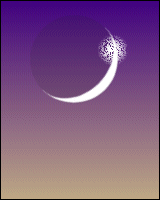The Giordano Bruno Crater
Created | Updated Mar 23, 2016
Moonbows | The Giordano Bruno Crater | Nicolas Louis de la Caille, his Lunar Crater and the X on the Terminator
Perigee-syzygy Moon, or, 'Supermoon' | Why the Far Side of the Moon Looks Different

This entry is not about Giordano Bruno the philosopher. It may not even be about the lunar crater named after him. It is about the evening of 18 June, 1178, just after sunset, Canterbury time.
In the September 1976 issue of the journal Meteoritics, Jack Hartung proposed that a heavenly apparition described by five men in 1178 may have been the impact of a meteorite on the moon. Hartung further suggested that the crater now named Giordano Bruno was the impact site. This was a bold hypothesis and it has been challenged.
The testimony of the five men is recorded in the Chronicle of Gervase of Canterbury:
Hoc anno, die Dominica ante Nativitatem Sancti Johannis Baptistae, post solis occasum, luna prima, signum apparuit mirabile, quinque vel eo amplius viris ex adverso sedentibus. Nam nova luna lucida erat, novitatis suae more cornua protendens ad orientem ; et ecce subito superius cornu in duo divisum est. Ex hujus divisionis medio prosilivit fax ardens, flamam, carbones et scintillas longius proiciens. Corpus interim luna quod inferius erat torquebatur quasi anxie, et, ut eorum verbia utar, qui hoc michi retulerunt et oculis viderunt propriis, ut percussus coluber luna palpitabat. Post hoc rediit in proprium statum. Hanc vicissitudinem duodecies et eo amplius repetiit, videlicet ut ignis tormenta varia sicut praelibatum est sustineret, iterumque in statum rediret priorem. Post bas itaque vidasitudines, a cornu usque in cornu scilicet per longum seminigra facta est. Haec michi qui haec scribo retulerunt viri illi qui suis hoc viderunt oculis, fidem suam vel jusjurandum dare parati, quod in supradictis nichil addiderunt falsitatis.
This year on the Sunday before the Feast of Saint John the Baptist, after sunset when the moon was first seen, a marvellous sign was seen by five or more men sitting facing it. Now, there was a clear new moon, as was usual at that phase, its horns extended to the east; and behold suddenly the upper horn was divided in two. Out of the middle of its division a burning torch sprang, throwing out a long way, flames, coals and sparks. As well, the moon's body which was lower, twisted as though anxious, and in the words of those who told me and had seen it with their own eyes, the moon palpitated like a pummelled snake. After this it returned to its proper state. This vicissitude repeated itself a dozen times or more, namely that the fire took on tormented forms variously at random, and afterwards returned to its prior state. Even after these vicissitudes, from horn to horn, that means along its length, it became semi-black. This to me who writes this was told by those men who with their own eyes saw it, and who are willing to swear an oath that they have not added to nor falsified the above written.
The text then goes on to describe an eclipse of the sun in September of that year.
Hartung suggests a number of possibilities to explain what happened: meteorological phenomena (clouds, atmospheric disturbances); the transit of a meteor; or an event on the moon. He rejects the first and second because the text of Gervase mentions nothing about the clouds or the sky. Hartung then goes to elaborate lengths to pinpoint the lunar latitude and longitude of the postulated impact and concludes that the crater Giordano Bruno is the perfect candidate for the impact scar.
Hartung's hypothesis has been popular with many people for a quarter of a century, but it has always had its critics. In the March 1977 issue of Meteoritics HH Nininger and Glenn I Huss argue that Hartung rejected the meteor transit theory too quickly and that, in fact, the best explanation for the 1178 apparition is a meteor entering the Earth's atmosphere along the line of sight between the witnesses and the moon. They argue that the type of event postulated by Hartung would have been virtually invisible from Canterbury, particularly as it happened on the far side of the moon.
In 2001, Paul Withers performed careful calculations of what the result of Hartung's postulated impact would have been. He found that in the weeks following such an impact there would have been a tremendous blizzard of meteors on Earth, something that could not have gone unremarked in the annals of the various cultures of the time. Withers' discovery lead to an official statement from NASA that the postulated impact never happened.
Investigators have been virtually unanimous in their respect for the integrity of the unnamed witnesses, believing that something must have been seen that June night in 1178. But there is at least one possible inconsistency in their testimony: Gervase tells us that the body of the moon, which was below the horns, began to writhe. On a crescent moon visible just after sunset the main part - the body, if you will - would be above the horns. The fact that this section of the chronicle includes a number of heavenly portents of future events (a solar eclipse comes next) suggests the possibility that Gervase or the five men may have had an agenda other than scientific investigation. It was a time of devotion to signs from above. Halley's Comet was seen in the previous century as an omen (good or bad, depending on your politics) of the Norman Conquest. There is still after all the calculations, the possibility that nothing at all unusual happened in the western sky of Canterbury, England, on 18 June, 1178.

